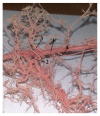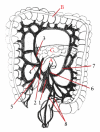Surgical Anatomy of the Gastrointestinal Tract and Its Vasculature in the Laboratory Rat
- PMID: 26819602
- PMCID: PMC4706906
- DOI: 10.1155/2016/2632368
Surgical Anatomy of the Gastrointestinal Tract and Its Vasculature in the Laboratory Rat
Abstract
The aim of this study was to describe and illustrate the morphology of the stomach, liver, intestine, and their vasculature to support the planning of surgical therapeutic methods in abdominal cavity. On adult Wistar rats corrosion casts were prepared from the arterial system and Duracryl Dental and PUR SP were used as a casting medium and was performed macroscopic anatomical dissection of the stomach, liver, and intestine was performed. The rat stomach was a large, semilunar shaped sac with composite lining. On the stomach was very marked fundus, which formed a blind sac (saccus cecus). The rat liver was divided into six lobes, but without gall bladder. Intestine of the rat was simple, but cecum had a shape as a stomach. The following variations were observed in the origin of the cranial mesenteric artery. On the corrosion cast specimens we noticed the presence of the anastomosis between middle colic artery (a. colica media) and left colic artery (a. colica sinistra). We investigated the second anastomosis between middle colic artery and left colic artery. The results of this study reveal that the functional anatomical relationship between the rat stomach, liver and intestine is important for the development of surgical research in human and veterinary medicine.
Figures













References
-
- Foster H. L., Small J. D., Fox J. G. The Mouse in Biomedical Research. Vol. 3. New York, NY, USA: Academic Press; 1983.
-
- Takahashi M., Pour P., Althoff J., Donnelly T. The pancreas of the Syrian hamster (Mesocricetus auratus). I. Anatomical study. Laboratory Animal Science. 1977;27(3):336–342. - PubMed
-
- Ehle F. R., Warner R. G. Nutritional implications of the hamster forestomach. Journal of Nutrition. 1978;108(7):1047–1053. - PubMed
-
- Barone R., Pavaux C., Blin P., Cuq P. Atlas d'Anatomie du Lapin. Paris, France: Mason; 1973.
LinkOut - more resources
Full Text Sources
Other Literature Sources
Molecular Biology Databases
Miscellaneous

